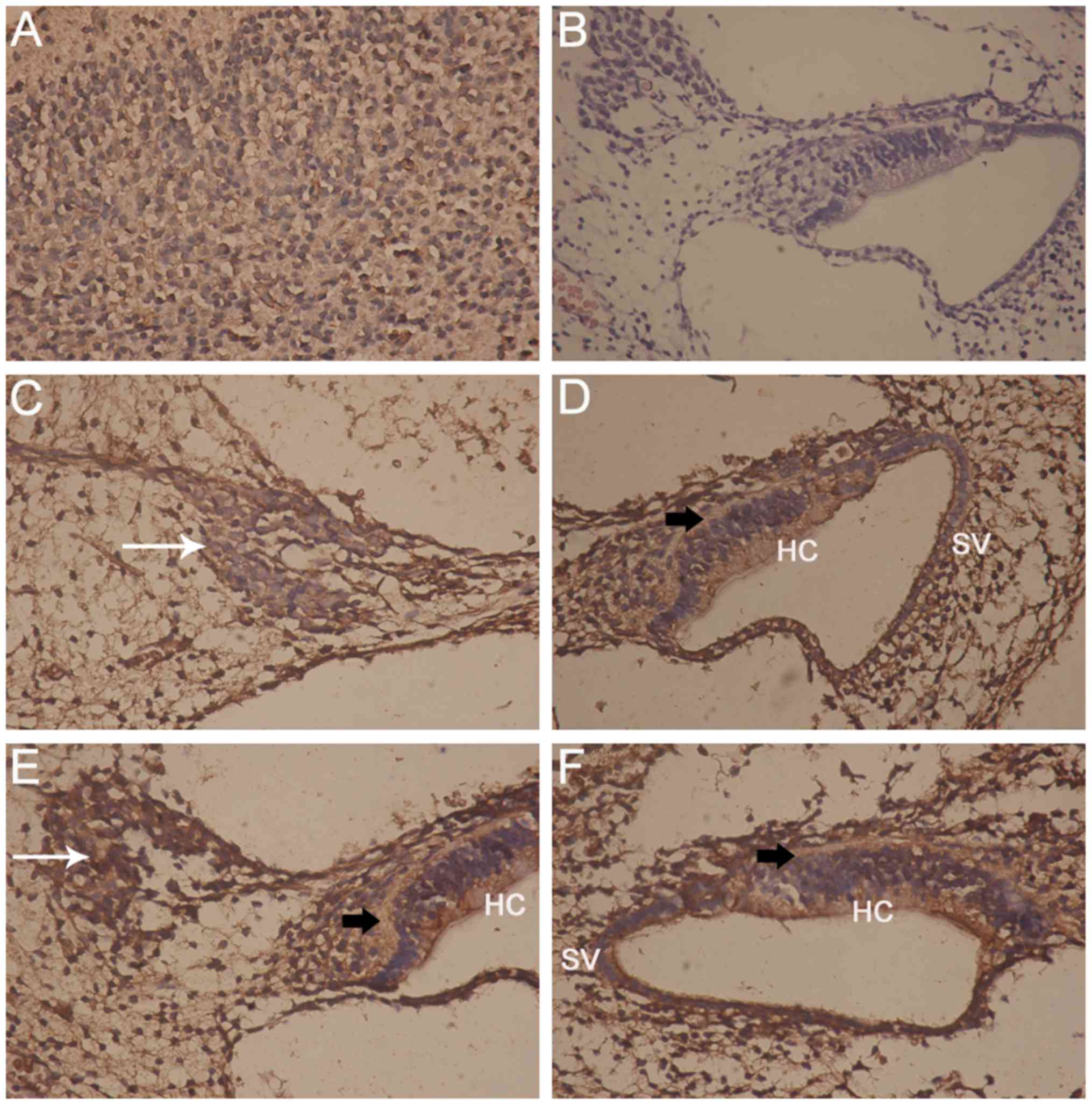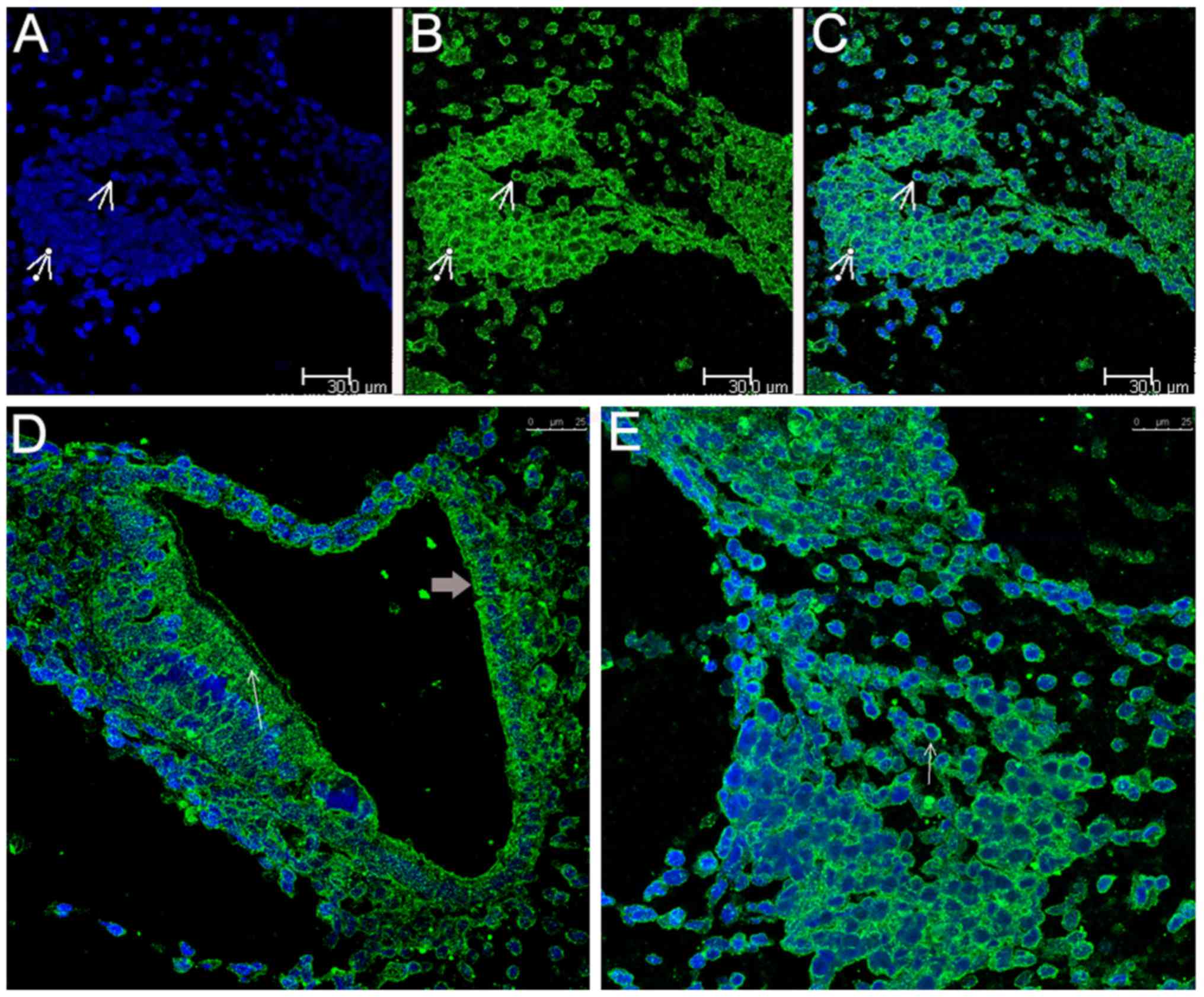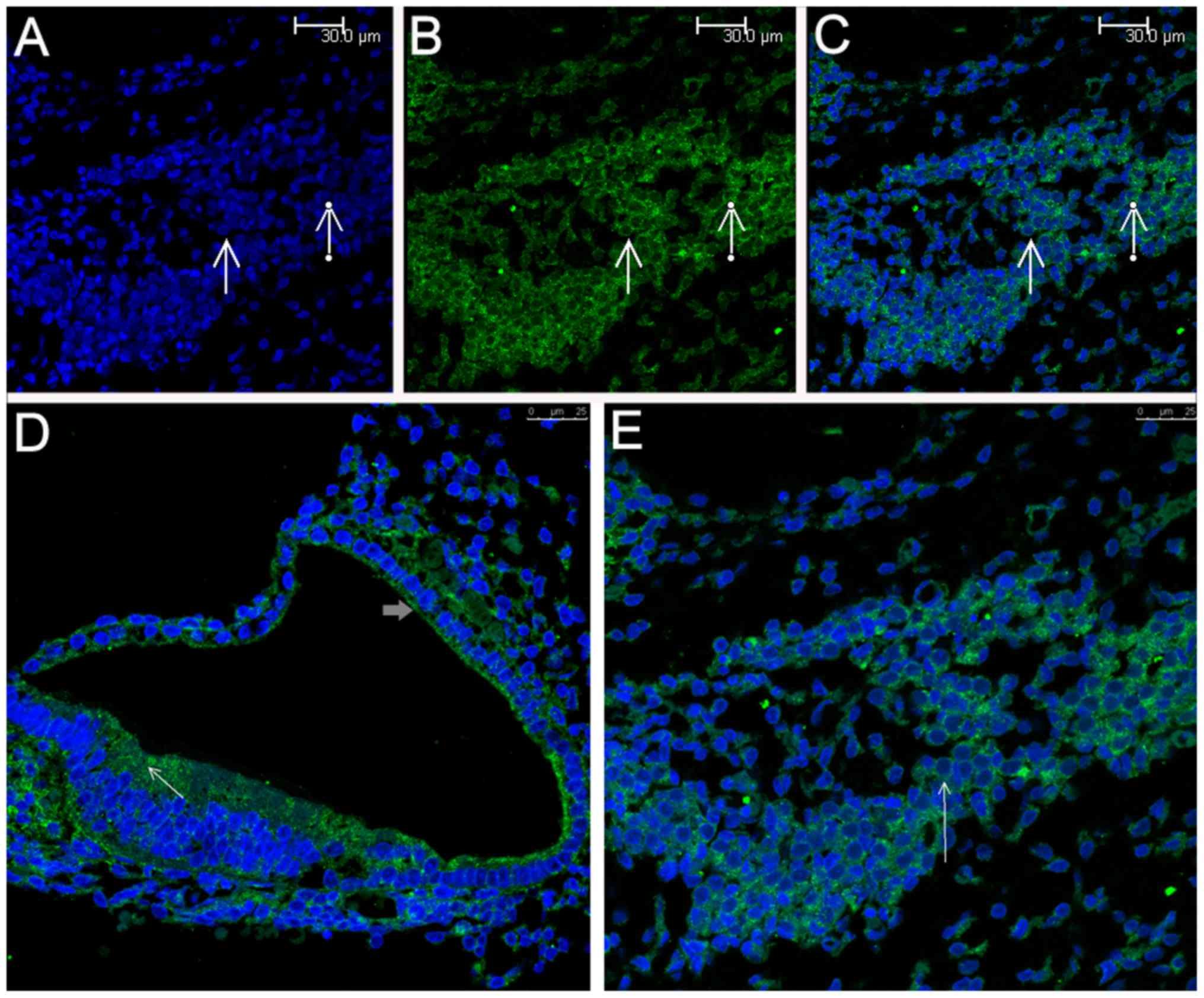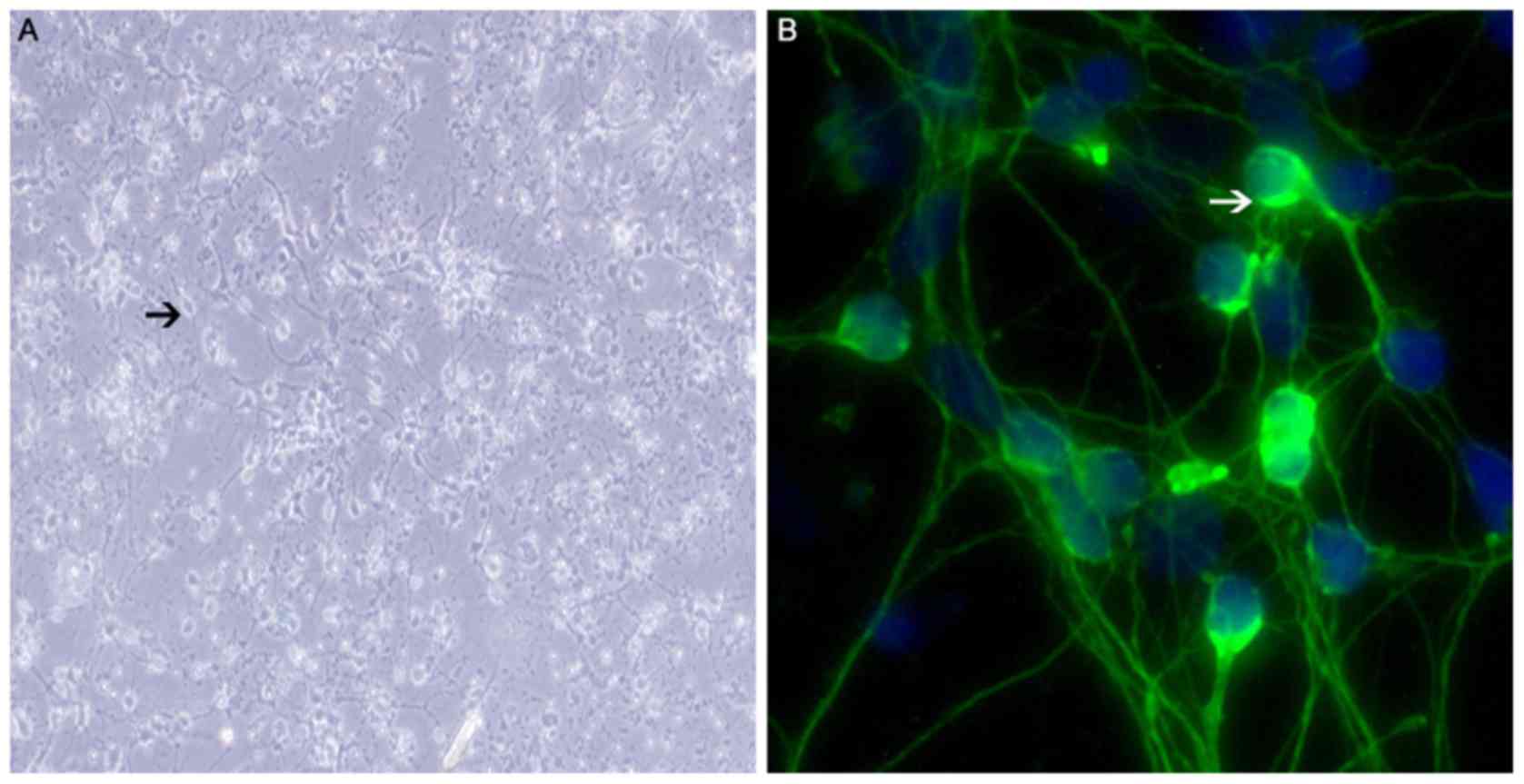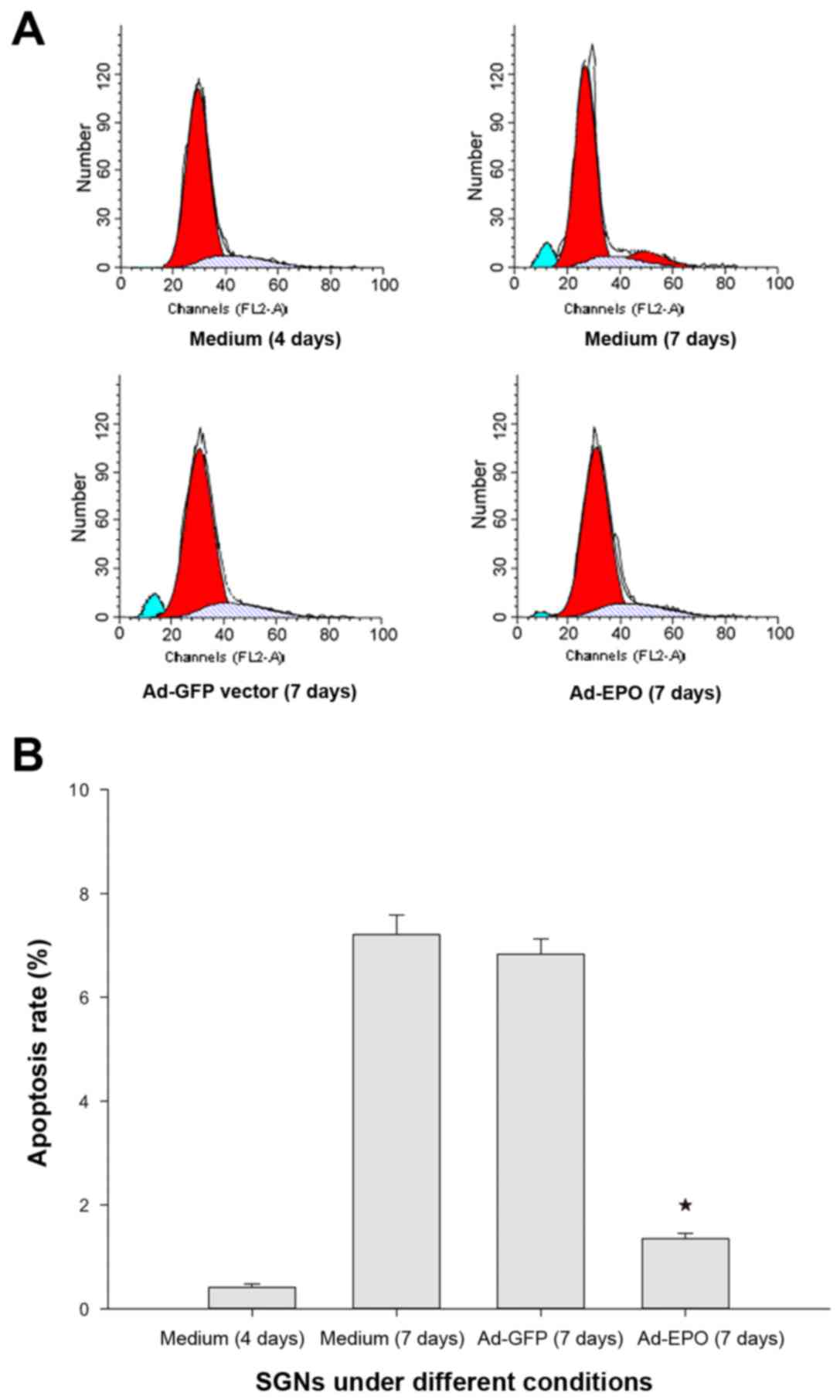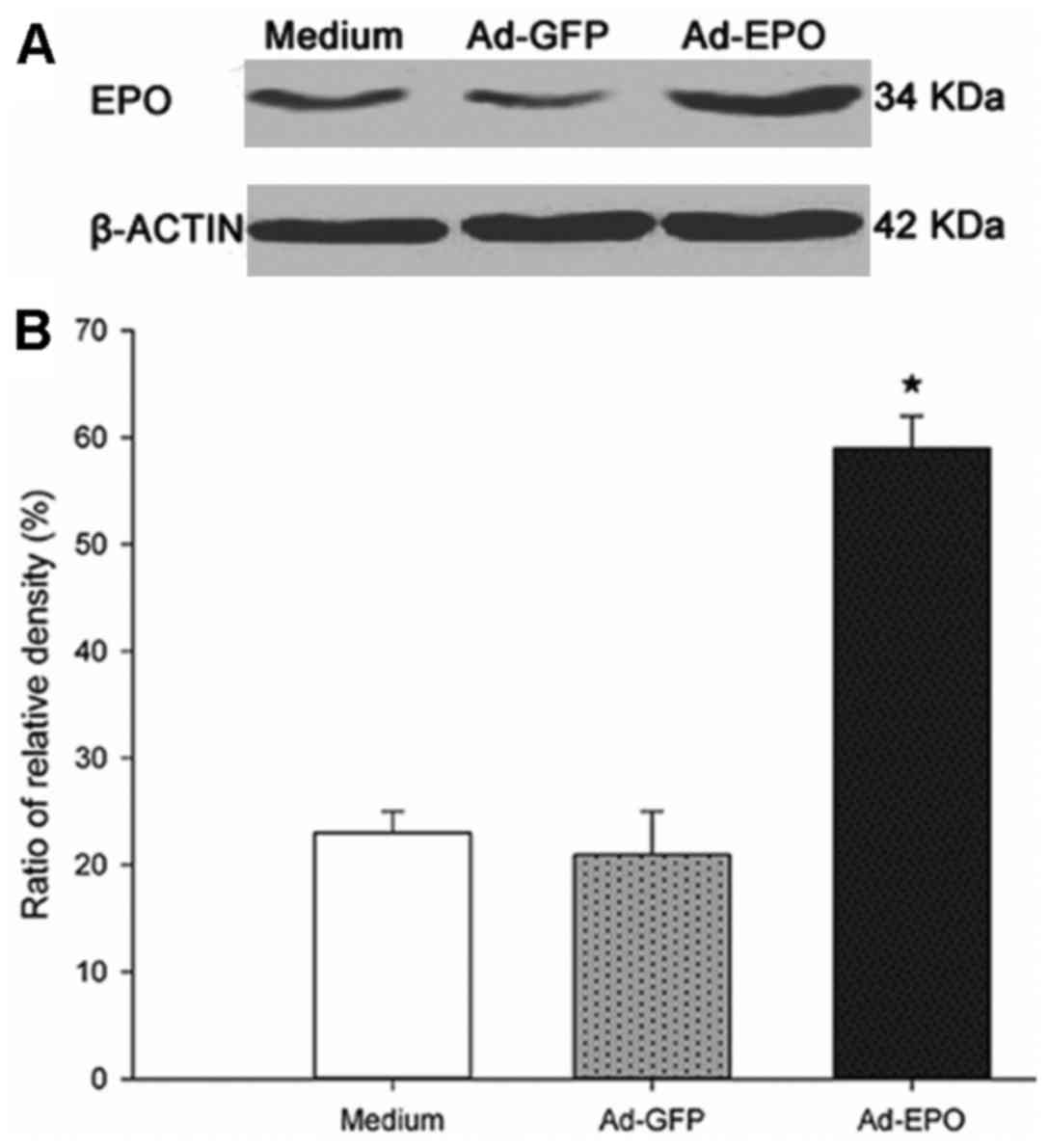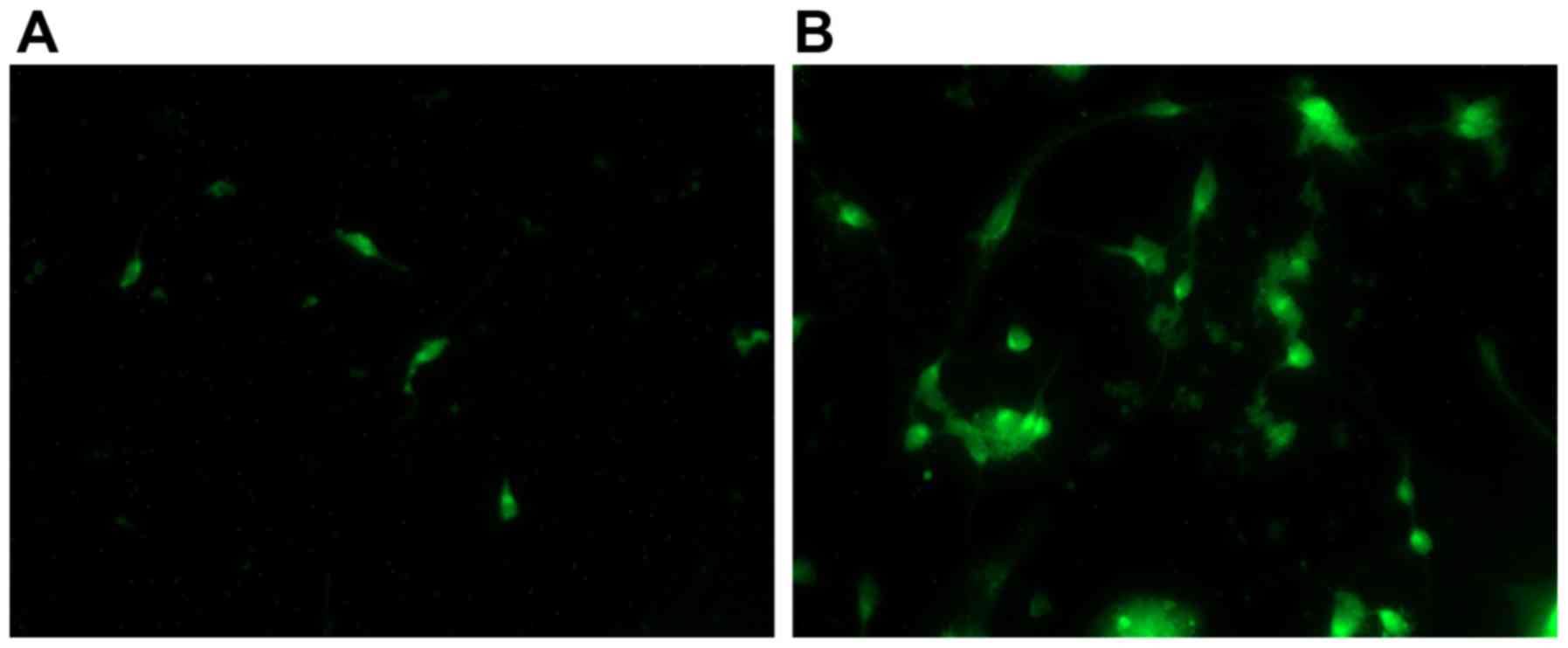|
1
|
Bartesaghi S, Marinovich M, Corsini E,
Galli CL and Viviani B: Erythropoietin: a novel neuroprotective
cytokine. Neurotoxicology. 26:923–928. 2005. View Article : Google Scholar : PubMed/NCBI
|
|
2
|
Rankin EB, Wu C, Khatri R, Wilson TL,
Andersen R, Araldi E, Rankin AL, Yuan J, Kuo CJ, Schipani E, et al:
The HIF signaling pathway in osteoblasts directly modulates
erythropoiesis through the production of EPO. Cell. 149:63–74.
2012. View Article : Google Scholar : PubMed/NCBI
|
|
3
|
Tugyan K, Ozbal S, Cilaker S, Kiray M,
Pekcetin C, Ergur BU and Kumral A: Neuroprotective effect of
erythropoietin on nandrolone decanoate-induced brain injury in
rats. Neurosci Lett. 533:28–33. 2013. View Article : Google Scholar
|
|
4
|
Traudt CM and Juul SE: Erythropoietin as a
neuroprotectant for neonatal brain injury: animal models. Methods
Mol Biol. 982:113–126. 2013. View Article : Google Scholar : PubMed/NCBI
|
|
5
|
Kwon BK, Okon E, Hillyer J, Mann C,
Baptiste D, Weaver LC, Fehlings MG and Tetzlaff W: A systematic
review of non-invasive pharmacologic neuroprotective treatments for
acute spinal cord injury. J Neurotrauma. 28:1545–1588. 2011.
View Article : Google Scholar :
|
|
6
|
Wang Y, Yao M, Zhou C, Dong D, Jiang Y,
Wei G and Cui X: Erythropoietin promotes spinal cord-derived neural
progenitor cell proliferation by regulating cell cycle.
Neuroscience. 167:750–757. 2010. View Article : Google Scholar : PubMed/NCBI
|
|
7
|
Colella P and Auricchio A: Photoreceptor
degeneration in mice: adeno-associated viral vector-mediated
delivery of erythropoietin. Methods Mol Biol. 982:237–263. 2013.
View Article : Google Scholar : PubMed/NCBI
|
|
8
|
Chang ZY, Yeh MK, Chiang CH, Chen YH and
Lu DW: Erythropoietin protects adult retinal ganglion cells against
NMDA-, trophic factor withdrawal-, and TNF-α-induced damage. PLoS
One. 8:e552912013. View Article : Google Scholar
|
|
9
|
Yoshida S, Nakama T, Ishikawa K, Arima M,
Tachibana T, Nakao S, Sassa Y, Yasuda M, Enaida H, Oshima Y, et al:
Antiangiogenic shift in vitreous after vitrectomy in patients with
proliferative diabetic retinopathy. Invest Ophthalmol Vis Sci.
53:6997–7003. 2012. View Article : Google Scholar : PubMed/NCBI
|
|
10
|
Jacobson LO, Goldwasser E, Fried W and
Plzak LF: Studies on erythropoiesis. VII. The role of the kidney in
the production of erythropoietin. Trans Assoc Am Physicians.
70:305–317. 1957.PubMed/NCBI
|
|
11
|
Jelkmann W: Erythropoietin: structure,
control of production, and function. Physiol Rev. 72:449–489. 1992.
View Article : Google Scholar : PubMed/NCBI
|
|
12
|
Lundby C, Hellsten Y, Jensen MB, Munch AS
and Pilegaard H: Erythropoietin receptor in human skeletal muscle
and the effects of acute and long-term injections with recombinant
human erythropoietin on the skeletal muscle. J Appl Physiol (1985).
104:1154–1160. 2008. View Article : Google Scholar
|
|
13
|
Anagnostou A, Liu Z, Steiner M, Chin K,
Lee ES, Kessimian N and Noguchi CT: Erythropoietin receptor mRNA
expression in human endothelial cells. Proc Natl Acad Sci USA.
91:3974–3978. 1994. View Article : Google Scholar : PubMed/NCBI
|
|
14
|
Shingo T, Sorokan ST, Shimazaki T and
Weiss S: Erythropoietin regulates the in vitro and in vivo
production of neuronal progenitors by mammalian forebrain neural
stem cells. J Neurosci. 21:9733–9743. 2001.PubMed/NCBI
|
|
15
|
Zhao W, Kitidis C, Fleming MD, Lodish HF
and Ghaffari S: Erythropoietin stimulates phosphorylation and
activation of GATA-1 via the PI3-kinase/AKT signaling pathway.
Blood. 107:907–915. 2006. View Article : Google Scholar
|
|
16
|
Wenker SD, Chamorro ME, Vittori DC and
Nesse AB: Protective action of erythropoietin on neuronal damage
induced by activated microglia. FEBS J. 280:1630–1642. 2013.
View Article : Google Scholar : PubMed/NCBI
|
|
17
|
Olgun Y, Kırkım G, Kolatan E, Kıray M,
Bağrıyanık A, Şerbetçioğlu B, Yılmaz O, Gökmen N, Ellidokuz H,
Kumral A, et al: Otoprotective effect of recombinant
erythro-poietin in a model of newborn hypoxic-ischemic
encephalopathy. Int J Pediatr Otorhinolaryngol. 77:739–746. 2013.
View Article : Google Scholar : PubMed/NCBI
|
|
18
|
Stephenson L: Structure and innervation of
the cochlea and organ of corti. J Vis Commun Med. 35:1592012.
View Article : Google Scholar
|
|
19
|
Raphael Y and Altschuler RA: Structure and
innervation of the cochlea. Brain Res Bull. 60:397–422. 2003.
View Article : Google Scholar : PubMed/NCBI
|
|
20
|
Vandenbosch R, Chocholova E, Robe PA, Wang
Y, Lambert C, Moonen G, Lallemend F, Malgrange B and Hadjab S: A
role for the canonical nuclear factor-κB pathway in coupling
neurotrophin-induced differential survival of developing spiral
ganglion neurons. Front Cell Neurosci. 7:2422013. View Article : Google Scholar
|
|
21
|
Shepherd RK, Coco A, Epp SB and Crook JM:
Chronic depolarization enhances the trophic effects of
brain-derived neurotrophic factor in rescuing auditory neurons
following a sensorineural hearing loss. J Comp Neurol. 486:145–158.
2005. View Article : Google Scholar : PubMed/NCBI
|
|
22
|
Nakaizumi T, Kawamoto K, Minoda R and
Raphael Y: Adenovirus-mediated expression of brain-derived
neurotrophic factor protects spiral ganglion neurons from ototoxic
damage. Audiol Neurootol. 9:135–143. 2004. View Article : Google Scholar : PubMed/NCBI
|
|
23
|
Fukui H, Wong HT, Beyer LA, Case BG,
Swiderski DL, Di Polo A, Ryan AF and Raphael Y: BDNF gene therapy
induces auditory nerve survival and fiber sprouting in deaf Pou4f3
mutant mice. Sci Rep. 2:8382012. View Article : Google Scholar : PubMed/NCBI
|
|
24
|
Cayé-Thomasen P, Wagner N, Lidegaard
Frederiksen B, Asal K and Thomsen J: Erythropoietin and
erythropoietin receptor expression in the guinea pig inner ear.
Hear Res. 203:21–27. 2005. View Article : Google Scholar : PubMed/NCBI
|
|
25
|
Lefebvre PP, Van de Water TR, Weber T,
Rogister B and Moonen G: Growth factor interactions in cultures of
dissociated adult acoustic ganglia: neuronotrophic effects. Brain
Res. 567:306–312. 1991. View Article : Google Scholar : PubMed/NCBI
|
|
26
|
Wefstaedt P, Scheper V, Lenarz T and
Stöver T: Brain-derived neurotrophic factor/glial cell line-derived
neurotrophic factor survival effects on auditory neurons are not
limited by dexamethasone. Neuroreport. 16:2011–2014. 2005.
View Article : Google Scholar : PubMed/NCBI
|
|
27
|
Liu D, Hu L, Zhang Z, Li QY and Wang G:
Construction of human BMP2-IRES-hIF1αmu adenovirus
expression vector and its expression in mesenchymal stem cells. Mol
Med Rep. 7:659–663. 2013. View Article : Google Scholar
|
|
28
|
Shen CF and Kamen A: Hyperosmotic pressure
on HEK 293 cells during the growth phase, but not the production
phase, improves adenovirus production. J Biotechnol. 157:228–236.
2012. View Article : Google Scholar
|
|
29
|
Graham FL and Prevec L: Manipulation of
adenovirus vectors. Methods Mol Biol. 7:109–128. 1991.PubMed/NCBI
|
|
30
|
Struglics A, Larsson S, Pratta MA, Kumar
S, Lark MW and Lohmander LS: Human osteoarthritis synovial fluid
and joint cartilage contain both aggrecanase- and matrix
metalloproteinase-generated aggrecan fragments. Osteoarthritis
Cartilage. 14:101–113. 2006. View Article : Google Scholar
|
|
31
|
Berkingali N, Warnecke A, Gomes P, Paasche
G, Tack J, Lenarz T and Stöver T: Neurite outgrowth on cultured
spiral ganglion neurons induced by erythropoietin. Hear Res.
243:121–126. 2008. View Article : Google Scholar : PubMed/NCBI
|
|
32
|
Stachler RJ, Chandrasekhar SS, Archer SM,
Rosenfeld RM, Schwartz SR, Barrs DM, Brown SR, Fife TD, Ford P,
Ganiats TG, et al American Academy of Otolaryngology-Head and Neck
Surgery: Clinical practice guideline: sudden hearing loss.
Otolaryngol head Neck Surg. 146(Suppl 3): S1–S35. 2012. View Article : Google Scholar : PubMed/NCBI
|
|
33
|
Mattox DE and Simmons FB: Natural history
of sudden sensori-neural hearing loss. Ann Otol Rhinol Laryngol.
86:463–480. 1977. View Article : Google Scholar : PubMed/NCBI
|
|
34
|
Hellier WP, Wagstaff SA, O'Leary SJ and
Shepherd RK: Functional and morphological response of the stria
vascularis following a sensorineural hearing loss. Hear Res.
172:127–136. 2002. View Article : Google Scholar : PubMed/NCBI
|
|
35
|
Feng H, Yin SH, Tang AZ and Tan SH:
Salicylate initiates apoptosis in the spiral ganglion neuron of
guinea pig cochlea by activating caspase-3. Neurochem Res.
36:1108–1115. 2011. View Article : Google Scholar : PubMed/NCBI
|
|
36
|
Choi MY, Yeo SW and Park Kh: Hearing
restoration in a deaf animal model with intravenous transplantation
of mesenchymal stem cells derived from human umbilical cord blood.
Biochem Biophys Res Commun. 427:629–636. 2012. View Article : Google Scholar : PubMed/NCBI
|
|
37
|
Needham K, Nayagam BA, Minter RL and
O'Leary SJ: Combined application of brain-derived neurotrophic
factor and neurotrophin-3 and its impact on spiral ganglion neuron
firing properties and hyperpolarization-activated currents. Hear
Res. 291:1–14. 2012. View Article : Google Scholar : PubMed/NCBI
|
|
38
|
Shibata SB, Budenz CL, Bowling SA, Pfingst
BE and Raphael Y: Nerve maintenance and regeneration in the damaged
cochlea. Hear Res. 281:56–64. 2011. View Article : Google Scholar : PubMed/NCBI
|
|
39
|
Conde de Felipe MM, Feijoo Redondo A,
García-Sancho J, Schimmang T and Durán Alonso MB: Cell- and gene-
therapy approaches to inner ear repair. Histol Histopathol.
26:923–940. 2011.PubMed/NCBI
|
|
40
|
Tan CC, Eckardt KU, Firth JD and Ratcliffe
PJ: Feedback modulation of renal and hepatic erythropoietin mRNA in
response to graded anemia and hypoxia. Am J Physiol. 263:F474–F481.
1992.PubMed/NCBI
|
|
41
|
Masuda S, Okano M, Yamagishi K, Nagao M,
Ueda M and Sasaki R: A novel site of erythropoietin production.
Oxygen-dependent production in cultured rat astrocytes. J Biol
Chem. 269:19488–19493. 1994.PubMed/NCBI
|
|
42
|
Liu C, Shen K, Liu Z and Noguchi CT:
Regulated human eryth-ropoietin receptor expression in mouse brain.
J Biol Chem. 272:32395–32400. 1997. View Article : Google Scholar
|
|
43
|
Sasaki R, Masuda S and Nagao M:
Erythropoietin: multiple physiological functions and regulation of
biosynthesis. Biosci Biotechnol Biochem. 64:1775–1793. 2000.
View Article : Google Scholar : PubMed/NCBI
|
|
44
|
Rahimi Nedjat M, Wähmann M, Bächli H,
Güresir E, Vatter H, Raabe A, Heimann A, Kempski O and Alessandri
B: Erythropoietin neuroprotection is enhanced by direct cortical
application following subdural blood evacuation in a rat model of
acute subdural hematoma. Neuroscience. 238:125–134. 2013.
View Article : Google Scholar : PubMed/NCBI
|
|
45
|
Undén J, Sjölund C, Länsberg JK, Wieloch
T, Ruscher K and Romner B: Post-ischemic continuous infusion of
erythropoeitin enhances recovery of lost memory function after
global cerebral ischemia in the rat. BMC Neurosci. 14:272013.
View Article : Google Scholar : PubMed/NCBI
|
|
46
|
Monge A, Nagy I, Bonabi S, Schmid S,
Gassmann M and Bodmer D: The effect of erythropoietin on
gentamicin-induced auditory hair cell loss. Laryngoscope.
116:312–316. 2006. View Article : Google Scholar : PubMed/NCBI
|
|
47
|
Andreeva N, Nyamaa A, Haupt H, Gross J and
Mazurek B: Recombinant human erythropoietin prevents
ischemia-induced apoptosis and necrosis in explant cultures of the
rat organ of Corti. Neurosci Lett. 396:86–90. 2006. View Article : Google Scholar
|
|
48
|
Gross J, Moller R, Amarjargal N, Machulik
A, Fuchs J, Ungethüm U, Kuban RJ, Henke W, Haupt H and Mazurek B:
Expression of erythropoietin and angiogenic growth factors
following inner ear injury of newborn rats. Prague Med Rep.
110:310–331. 2009.
|
|
49
|
Monge Naldi A, Gassmann M and Bodmer D:
Erythropoietin but not VEGF has a protective effect on auditory
hair cells in the inner ear. Cell Mol Life Sci. 66:3595–3599. 2009.
View Article : Google Scholar : PubMed/NCBI
|
|
50
|
Kaiser O, Paasche G, Stöver T, Ernst S,
Lenarz T, Kral A and Warnecke A: TGF-beta superfamily member
activin A acts with BDNF and erythropoietin to improve survival of
spiral ganglion neurons in vitro. Neuropharmacology. 75:416–425.
2013. View Article : Google Scholar : PubMed/NCBI
|
|
51
|
Han F, Yu H, Zheng T, Ma X, Zhao X, Li P,
Le L, Su Y and Zheng QY: Otoprotective effects of erythropoietin on
Cdh23erl/erl mice. Neuroscience. 237:1–6. 2013.
View Article : Google Scholar : PubMed/NCBI
|
|
52
|
Frederiksen BL, Cayé-Thomasen P, Lund SP,
Wagner N, Asal K, Olsen NV and Thomsen J: Does erythropoietin
augment noise induced hearing loss. Hear Res. 223:129–137. 2007.
View Article : Google Scholar
|
|
53
|
Buemi M, Cavallaro E, Floccari F, Sturiale
A, Aloisi C, Trimarchi M, Corica F and Frisina N: The pleiotropic
effects of erythropoietin in the central nervous system. J
Neuropathol Exp Neurol. 62:228–236. 2003. View Article : Google Scholar : PubMed/NCBI
|
|
54
|
Whitlon DS, Grover M, Tristano J, Williams
T and Coulson MT: Culture conditions determine the prevalence of
bipolar and monopolar neurons in cultures of dissociated spiral
ganglion. Neuroscience. 146:833–840. 2007. View Article : Google Scholar : PubMed/NCBI
|
|
55
|
Yilmaz M, Chemaly RF, Han XY, Thall PF,
Fox PS, Tarrand JJ, De Lima MJ, Hosing CM, Popat UR, Shpall E, et
al: Adenoviral infections in adult allogeneic hematopoietic SCT
recipients: a single center experience. Bone Marrow Transplant.
48:1218–1223. 2013. View Article : Google Scholar : PubMed/NCBI
|
|
56
|
Zhao B, Li X, Dai X and Gong N:
Adenovirus-mediated anti-sense extracellular signal-regulated
kinase 2 gene therapy inhibits activation of vascular smooth muscle
cells and angio-genesis, and ameliorates transplant
arteriosclerosis. Transplant Proc. 45:639–642. 2013. View Article : Google Scholar : PubMed/NCBI
|



